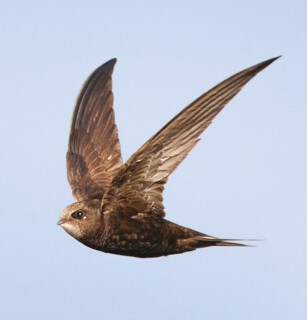A common swift , in its lifetime, flies about two million kilometres; enough to fly to the moon and back twice over, and then once more to the moon. Weighing less than a hen’s egg, with wings like a scythe and a tail like a fork, they eat and sleep on the wing. They gather nesting material only from what’s in the air, which means that there have been accounts of still-flapping butterflies wedged in among the leaves and twigs. They mate in brief mid-sky collisions, the only birds in the world to do so, and to wash they hunt down clouds and fly through gentle rain, slowly, wings outstretched.
Most remarkable of all is their night. Swifts can find a state of unihemispheric sleep; they shut off one half of their brain at a time, while the other remains functioning, alert to changes in the wind, so that the bird wakes in exactly the same place where it fell asleep; or, if migrating, on the precise course it set itself. The left side closes first, then the right, so that it sways a little in the air as it sleeps. Chaucer knew it long before we did: in the Canterbury Tales he wrote about small birds who ‘slepen al the nyght with open ye’. And a French pilot during the First World War, flying by the light of a full moon on a reconnaissance mission near Vosges, saw a ghostly cloud of them, apparently hovering entirely still in the air: ‘As we came to about ten thousand feet … we suddenly found ourselves among a strange flight of birds which seemed to be motionless, or at least showed no noticeable reaction. They were widely scattered and only a few yards below the aircraft, showing up against a white sea of cloud underneath. None was visible above us. We were soon in the middle of the flock.’ Nobody believed him, at the time: it seemed impossible, because swifts do seem impossible.
The swift is of the family Apodidae, from the Greek ápous, ‘footless’, because they were once believed to have no legs. We still know very little about them, because they’re so hard to catch and study, but we do at least know that they have legs, albeit tiny, weak ones. Adult swifts can walk if they absolutely have to, but younglings can’t, and, if all goes well, do not need to. They tip themselves from the nest and fly straight to Africa, some not alighting again for ten months, some for two years or four, and a few never stopping at all. We know that to prepare for their great flight, the young chicks in the nest strengthen their wings from a month old by doing feathery press-ups; lifting their bodies up off the nest by pressing down on their wings, until they can hold themselves there, suspended, for several seconds. Then they’re ready.
We still don’t know with absolute certainty how they know with such absolute certainty where to go. But we know that they’re fast. They are the swiftest of all birds in level flight (a peregrine can outstrip them in a dive, but they can outfly her in a flat race); the top speed ever officially recorded was 111.6 km per hour, but there are reports of the needle-tailed swift, found in Africa and Asia, reaching 170 km per hour. A swift flies about 200,000 km a year; the Earth has a diameter along the equator of 40,075 km; so a swift flies far enough each year to put five girdles round the Earth. It would be exhausting to contemplate, except that I have never seen a swift that looks exhausted.
That sky-high lack of exhaustion – and their raucous, questing cry – has long thrilled us. In heraldry, the swift is one of the inspirations for the imaginary martlet, a stylised bird without feet. Unable to land, the martlet is a symbol of restlessness and pursuit: of the constant search for knowledge and adventure and learning. They were used in coats of arms as the mark of the fourth son, on the reckoning that the first son got the money, the second and third went to the Church, and the fourth was free to seek his fortune. Edward the Confessor, a king so morally upright he was practically levitating, was given five martlets, posthumously, on his shield: gold, to match the sun they fly after.
The Apodidae family is ancient: it separated off from other birds about seventy million years ago, so they’re old enough as a species to have had a nodding acquaintance with the Tyrannosaurus. They evolved to have deep-set eyes with bristles in front, which act as sunglasses against the glare of the equatorial sun. There are more than a hundred species, from the tiny pygmy swiftlet, just nine cm across and found only in the Philippines, to the white-naped swift, a huge 25 cm across the wing, which is silent when alone and calls almost ceaselessly when with its flock, cree cree cree.
If you see a bird settled on a telegraph wire or a tree, it’s not a swift. No sociable windowsill singers, no Disney-Princess-finger-perchers, they fly wild, and they fly like a stroke of luck incarnate. But they would, like most living things, be far luckier without us; our swift, Apus Apus, which arrives in the UK for the mating season, is not yet critically endangered, but between 1995 and 2016 there was a 57 per cent drop in their breeding numbers. Our swifts mate for life, returning every year from Africa to the same spot to nest, usually in spaces under roof tiles and in the eaves of old houses and barns. As we knock down and seal up old buildings, the swifts can find nowhere safe to lay their eggs before the breeding season is over. They also suffer from mass industrialised pesticide use and global warming, both of which affect the insect population; swifts can eat only what’s in the air and a swift with chicks needs to gather as many as a hundred thousand insects a day, storing them in batches of a thousand in a bulge in their throat. And then there’s our own familiar deadly hunger, our compulsion to feast at another’s expense: birds’ nest soup, thought to clear the complexion and rejuvenate the body, requires the harvesting of vast numbers of the endangered swiftlets’ nests. These days, the swift’s cry could quite reasonably be heard as a warning.
Ted Hughes wrote a love poem to swifts in 1973. It catches at their glory, their racing high-pitched valiance, although it reads a little differently now:
They’ve made it again,
Which means the globe’s still working, the Creation’s
Still waking refreshed, our summer’s
Still all to come –
Send Letters To:
The Editor
London Review of Books,
28 Little Russell Street
London, WC1A 2HN
letters@lrb.co.uk
Please include name, address, and a telephone number.


